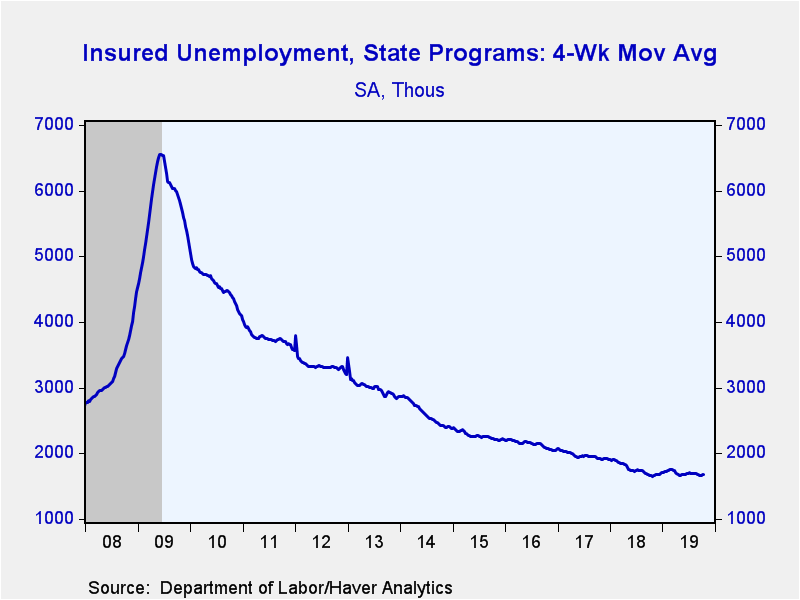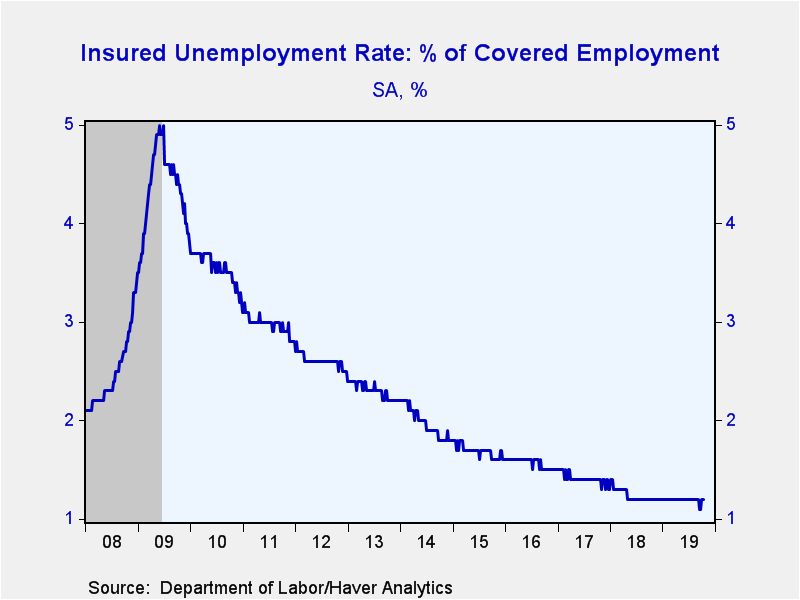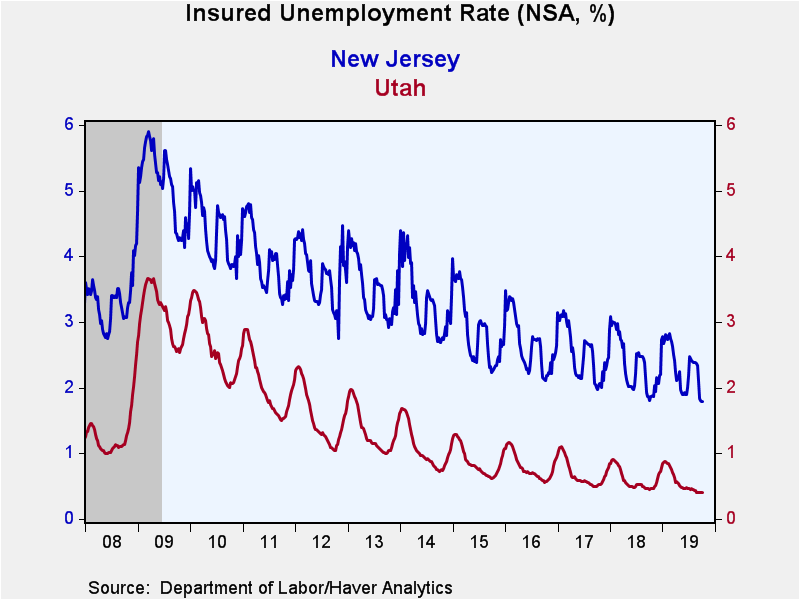 Global| Oct 24 2019
Global| Oct 24 2019U.S. Initial Claims for Unemployment Insurance Decrease in Week, Remain in 50-Year Low Range
Summary
Initial claims for unemployment insurance in the week ending October 19 fell 6,000 to 212,000 (-2.8% y/y) from 218,000 in the previous week, which was revised from 214,000. The Action Economics Forecast Survey expected 215,000. The [...]
Initial claims for unemployment insurance in the week ending October 19 fell 6,000 to 212,000 (-2.8% y/y) from 218,000 in the previous week, which was revised from 214,000. The Action Economics Forecast Survey expected 215,000. The four-week moving average of initial claims, which smooths out week-to-week volatility, decreased to 215,000 from 215,750. These amounts, in the range of 210,000 to 220,000 since March, constitute the lowest over a sustained period since 1969.
Continuing claims for unemployment insurance fell 1,000 in the week ending October 12 to 1.682 million (+1.6% y/y) from 1.683 million in the prior week, which was revised up from 1.679 million. Year-to-year increases in the last three weeks are the first such annual increases since January 9, 2010, that is, early in the recovery from the Great Recession.
The insured rate of unemployment for the week ending October 12 was 1.2% for a third week after two weeks at the record low of 1.1%. Data on the insured unemployment rate go back to 1971.
Insured rates of unemployment vary widely by state. During the week ending October 5, the lowest rates were in Nebraska (0.18%), South Dakota (0.19%), North Dakota (0.32%), Utah (0.40%), and New Hampshire (0.41%). The highest rates were in Pennsylvania (1.44%), California (1.51%), Connecticut (1.52%), Alaska (1.66%), and New Jersey (1.79%). Among the other largest states by population not mentioned above, the rate was 0.89% in Texas, 0.43% in Florida, and 1.14% in New York. These state data are not seasonally adjusted.
Data on weekly unemployment claims going back to 1967 are contained in Haver's WEEKLY database, and they are summarized monthly in USECON. Data for individual states are in REGIONW. The expectations figure is from the Action Economics Forecast Survey, carried in the AS1REPNA database.
| Unemployment Insurance (SA, 000s) | 10/19/19 | 10/12/19 | 10/05/19 | Y/Y % | 2018 | 2017 | 2016 |
|---|---|---|---|---|---|---|---|
| Initial Claims | 212 | 218 | 210 | -2.8 | 220 | 244 | 262 |
| Continuing Claims | -- | 1,682 | 1,683 | 1.6 | 1,756 | 1,961 | 2,135 |
| Insured Unemployment Rate (%) | -- | 1.2 | 1.2 |
1.2 |
1.2 | 1.4 | 1.6 |
Carol Stone, CBE
AuthorMore in Author Profile »Carol Stone, CBE came to Haver Analytics in 2003 following more than 35 years as a financial market economist at major Wall Street financial institutions, most especially Merrill Lynch and Nomura Securities. She has broad experience in analysis and forecasting of flow-of-funds accounts, the federal budget and Federal Reserve operations. At Nomura Securites, among other duties, she developed various indicator forecasting tools and edited a daily global publication produced in London and New York for readers in Tokyo. At Haver Analytics, Carol is a member of the Research Department, aiding database managers with research and documentation efforts, as well as posting commentary on select economic reports. In addition, she conducts Ways-of-the-World, a blog on economic issues for an Episcopal-Church-affiliated website, The Geranium Farm. During her career, Carol served as an officer of the Money Marketeers and the Downtown Economists Club. She has a PhD from NYU's Stern School of Business. She lives in Brooklyn, New York, and has a weekend home on Long Island.









